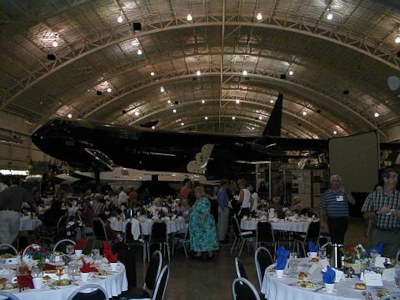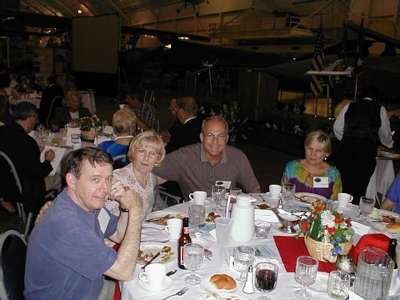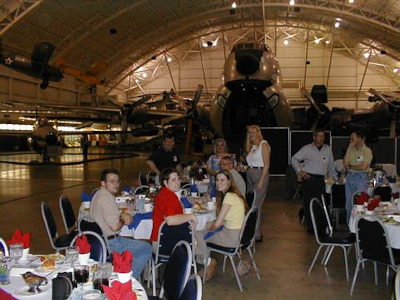


ARIA - the Trilogy
Lieutenant General Robert F. Raggio
ARIA Reunion Banquet
5 May 2001
General Skantze, General Odgers, General Nauseef, Colonel Ward, Colonel Phillips, alumni of the 4950th Test Wing and ARIA-- thank you. It is truly an honor for me to be here this evening and share this reunion banquet with all of you.
As many of you know, next month I will bring my Air Force career to a close. And I can honestly say that I’ve enjoyed every assignment in those 35 ½ years. But no assignment was better than the years I spent at the test wing with the men and women who flew and maintained the ARIA.
Without a doubt, the two assignments on which I will look back with fondest memories will be my years at the 4950th. Flying for the wing as a captain, and later returning to command that wing is a thrill few in the Air Force ever have an opportunity to enjoy. And I am grateful to everyone who served with me and made that experience so enjoyable. And many of you are here tonight.
The 4950th was a unique organization. When I came to the wing in December of 1975, we were flying 43 aircraft of some 15 different types. But by far the most distinctive, the most unique and in many ways the most important—was the “Droop Snoot” EC-135. ARIA flew a unique mission, deploying to locations all over the world to support varied civilian and military projects.
Throughout a crucial period in our nation’s history—ARIA was there--ready to fulfill mission that no other aircraft could.
For more than 30 years this strange-looking bird played a vital role in our civilian space program and in the development of our satellite and missile systems—helping to keep the Cold War cold, while allowing the world to progress into the era of manned space flight.
The concept of ARIA came about in the 1960s, when the National Aeronautics and Space Administration recognized that the lunar Apollo missions would require a highly-mobile platform that could “fill the gaps”—and relay tracking and telemetry voice and data transmissions from remote stations all over the world. The Department of Defense faced a similar requirement for tracking its unmanned orbital satellite launches, and its ballistic missile reentry test programs.
And so ARIA was born– a modified C-135 transport jet with a 10-foot radome housing a seven-foot steerable dish antennae. The aircraft also supported a probe antennae on each wingtip and a trailing wire antennae on the bottom of the fuselage. Designated the EC-135N, the first ARIA became operational in January 1968.
There are three distinct chapters in the ARIA history. The first chapter of the trilogy began at the Air Force Eastern Test Range at Patrick Air Force Base, Florida. In its seven years at Patrick, the initial fleet of eight aircraft and her crews racked up an impressive set of accomplishments. ARIA supported the first manned mission to the moon in July 1969-- receiving, recording and relaying telemetry data and voice communications between astronauts and mission control in Houston.
Nine months later in April 1970, it was an ARIA that relayed the now-infamous words from Apollo 13: “Houston, we’ve had a problem here.”
When the situation seemed desperate for our three astronauts, it was an ARIA that relayed critical data and voice transmissions between mission control and the command module, two hundred thousand miles from Earth. These communications allowed the crew to make the configurations necessary to prepare to return safely to Earth.
ARIA supported every Apollo mission, including the joint Apollo-Soyuz mission, as well as the Skylab missions.
As the Apollo program came to a close, the mission was moved December 1975 to Wright-Patterson Air Force Base as part of the newly formed 4950th Test Wing, and the second chapter of ARIA began.
In its years at Wright-Patt, ARIA took an active role in operational support for weapons development. Our aircraft provided the critical information necessary to develop every major ballistic missile in our inventory. ARIA was there for the test and development of air, land and sea-launched cruise missiles, the Army’s Pershing I and Pershing II, and the Navy’s Trident, Poseidon and Polaris ballistic missiles.
We were a unique entity in the Air Force, and certainly within the test wing. Deploying to locations all over the world, we had to be prepared for any situation and any contingency. We traveled with our own complement maintenance personnel and crew chiefs, and our cargo holds were always crammed with spare parts and extra electronic equipment.
Our prime mission electronic equipment operators, or PMEEs, spent one to two years working at a bench before they started flight training. And it was not uncommon to find them performing depot-level maintenance on the road, taking radios apart and soldering away, minutes before a launch.
The readiness of our crews faced a major test during the first Space Shuttle mission. The flight recorders aboard the shuttle had failed. And it soon became apparent as the craft was preparing to re-enter the Earth’s atmosphere that unless something was done quickly, there would be no way to record the shuttle’s heat shield re-entry performance data.
An ARIA supporting cruise missile flight tests at Edwards Air Force Base was tasked to take off and receive and record the information. While en-route to the zone, calls were made between mission control, ARIA control, and the aircraft to reconfigure the equipment to receive the data.
A process that normally took three days on the ground was accomplished in just two hours while in the air. ARIA saved that day for NASA.
Deployments took our crews to some pretty choice locations—Barbados, Tahiti, New Zealand and Australia, among others. But not all every trip was pleasant experience. Like the time in 1980 when three ARIA crews stopped in Surinam for refueling and crew rest. Crews awoke in the morning to find the country in the middle of a coup.
Sixty-five members of the wing, including the commander, Colonel Ward were detained and held at gunpoint before being allowed to leave the country many hours later. But our people kept their cool, and when communications in the country were cut, they were able to route important message traffic from the embassy to ARIA control, and from there, to the State Department.
At less harrowing moments, we knew how to have a good time. I’ll never forget my experience at a wing dining-in. [Gen. Raggio’s personal recollections].
While we had our share of good times, unfortunately ARIA was not immune to tragedy. In 1981 we lost 21 people, including two military spouses, when ARIA 328 crashed on a training mission over Maryland. This loss hit everyone associated with the 4950th-- and we mourned as a family at the loss of our cherished friends and colleagues.
But we also took solace in the fact that their sacrifice came in the service of their country-- in the cause of peace. Their contributions in no small part helped ensure our victory in the Cold War.
The third and final chapter of the ARIA trilogy began in 1994. The Air Force decided to consolidate all of the 4950th test and evaluation assets to Edwards Air Force Base. By this time the ARIA fleet also included EC-18Bs, which could carry a larger payload and operate on shorter runways than the 135s.
In its time at the 412th Test Wing, ARIA continued to play an integral role in our civilian space program, supporting projects such as the X-Ray Timing Explorer and the Solar and Heliospheric Observatory. More recently, it was a key player in the test and development of the conventional air launched cruise missile.
When ARIA finally stands down on September 30th of this year, it will take with it a rich legacy of service. Throughout its rich history, ARIA was always there.
When Americans first walked on the moon-- ARIA was there. When our country was developing the ballistic missile systems that helped bring the Cold War to an end-- ARIA was there. And when our country launched the satellite systems that drive today’s era of instant communications-- ARIA was there, performing a mission that no other aircraft could.
Being part of ARIA history and the ARIA family is without a doubt one of the highlights of my career. Unless you’ve experienced it yourself, you can never fully appreciate the camaraderie and fellowship that those in this tight-knit community share for each other and their aircraft.
And while history of ARIA will now come to a close, one thing that will always remain with us is the special bond that exists between all of those who were ever associated this mission and this remarkable aircraft.
Thank you.